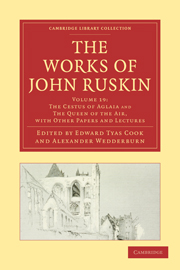Book contents
- Frontmatter
- Contents
- LIST OF ILLUSTRATIONS
- INTRODUCTION TO THIS VOLUME
- PART I “SIR JOSHUA AND HOLBEIN” (1860)
- PART II “THE STUDY OF ARCHITECTURE IN SCHOOLS” (1865)
- PART III “THE CESTUS OF AGLAIA” (1865, 1866)
- PART IV “THE RELATION OF NATIONAL ETHICS TO NATIONAL ARTS,” BEING THE REDE LECTURE FOR 1867
- PART V “ON THE PRESENT STATE OF MODERN ART, WITH REFERENCE TO THE ADVISABLE ARRANGEMENT OF A NATIONAL GALLERY” (1867)
- PART VI “FAIRY STORIES”: A PREFACE TO “GERMAN POPULAR STORIES” (1868)
- PART VII “THE FLAMBOYANT ARCHITECTURE OF THE VALLEY OF THE SOMME” (1869)
- PART VIII “THE QUEEN OF THE AIR” (1869)
- PART IX “VERONA, AND ITS RIVERS” (1870)
- APPENDIX: REPORTS OF ADDRESSES ON ART
- Plate section
PART IX - “VERONA, AND ITS RIVERS” (1870)
Published online by Cambridge University Press: 05 November 2011
- Frontmatter
- Contents
- LIST OF ILLUSTRATIONS
- INTRODUCTION TO THIS VOLUME
- PART I “SIR JOSHUA AND HOLBEIN” (1860)
- PART II “THE STUDY OF ARCHITECTURE IN SCHOOLS” (1865)
- PART III “THE CESTUS OF AGLAIA” (1865, 1866)
- PART IV “THE RELATION OF NATIONAL ETHICS TO NATIONAL ARTS,” BEING THE REDE LECTURE FOR 1867
- PART V “ON THE PRESENT STATE OF MODERN ART, WITH REFERENCE TO THE ADVISABLE ARRANGEMENT OF A NATIONAL GALLERY” (1867)
- PART VI “FAIRY STORIES”: A PREFACE TO “GERMAN POPULAR STORIES” (1868)
- PART VII “THE FLAMBOYANT ARCHITECTURE OF THE VALLEY OF THE SOMME” (1869)
- PART VIII “THE QUEEN OF THE AIR” (1869)
- PART IX “VERONA, AND ITS RIVERS” (1870)
- APPENDIX: REPORTS OF ADDRESSES ON ART
- Plate section
Summary
1. If you chance to be at Verona on a clear, warm summer's day, and to be weary—as may well happen—at the end of it, take a light carriage, and drive out at the eastern gate (on the way to the station for Venice). You will see, fifty yards beyond the gate, a good road turning to the left—and from that, as immediately, another turning to the left again, which, by a gradual slope, begins to ascend the hill on which the eastern walls of Verona are built.
You will then presently find yourself, if it is towards evening, in the shade of those walls, and in cool and pure air, ascending, by a winding road, a hill covered with maize and vines; into the rocks of which, between you and the city walls, a steep ditch has been cut,—some thirty feet deep by sixty or eighty wide,—the defence of the city on that side being trusted to this one magnificent trench cut out of the solid rock, and to the precipice-like wall, above, with towers, crested with forked battlements, set along it at due intervals.
2. It was possible to cut that rock-trench—which, as you will find presently—is carried up the hill beside you for about an English mile—without gunpowder, because the rock is a soft and crumbling limestone, on which, when you see the dusty banks of it emerge under the hedges by the roadside, you, if a member of the Royal Institution, must look with great reverence.
- Type
- Chapter
- Information
- The Works of John Ruskin , pp. 425 - 458Publisher: Cambridge University PressPrint publication year: 2010First published in: 1905

